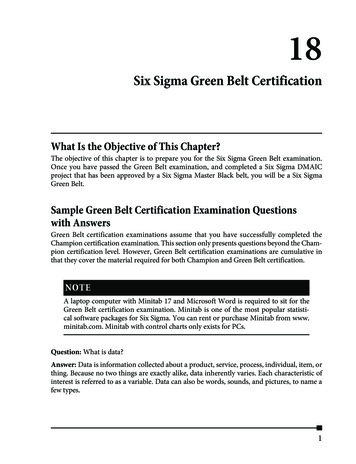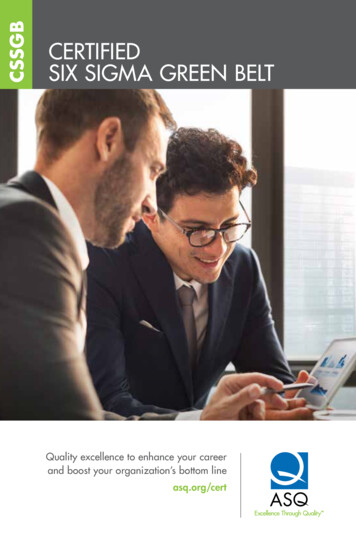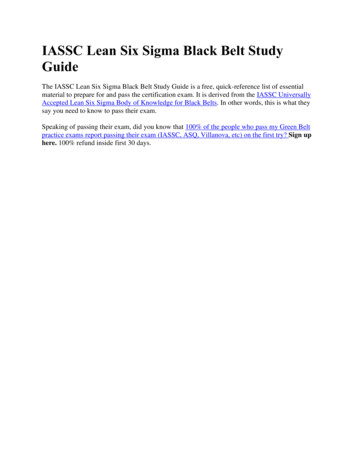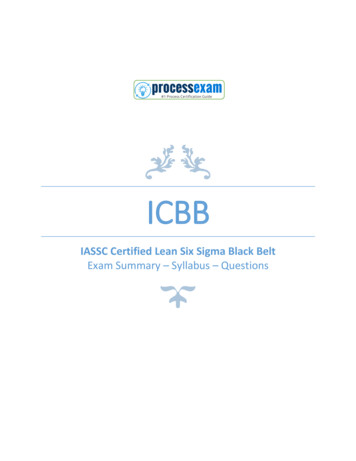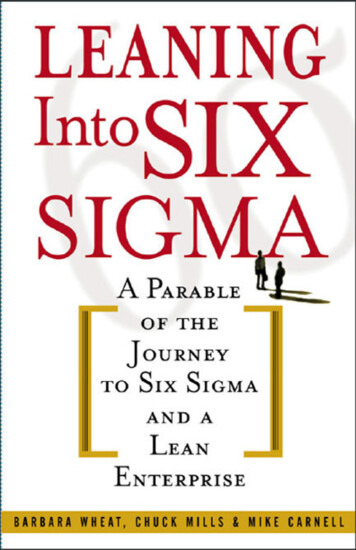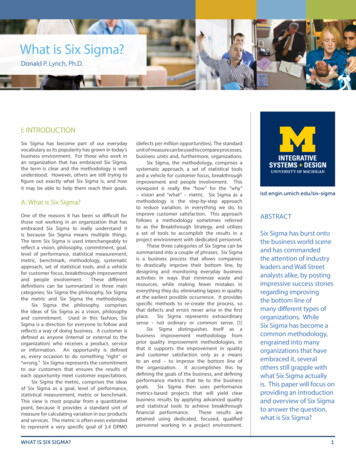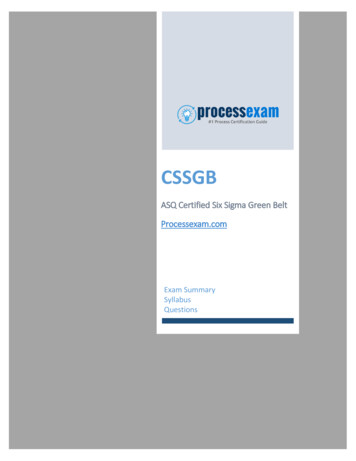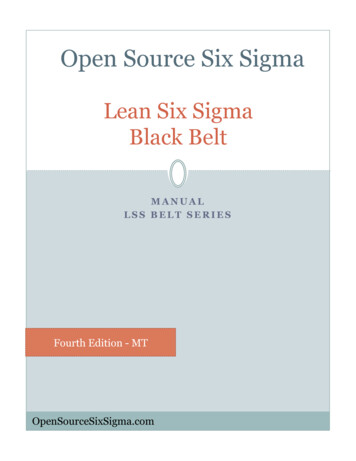
Transcription
Open Source Six SigmaLean Six SigmaBlack BeltMANUALLSS BELT SERIESFourth Edition - MTOpenSourceSixSigma.com
Lean Six Sigma Black BeltFourth Edition ManualBased on Version 12.0 Training MaterialsMinitabTM v17An Open Source Six Sigma LLC Publication6200 East Thomas Road Suite 203Scottsdale Arizona 85251Phone: 1 480 270 8438Email: osss@opensourcesixsigma.comWebsite: www.OpenSourceSixSigma.comOSSS Lean Six Sigma Black Belt Manual 2007 & 2015 by Open Source Six Sigma. All rights are reserved. Individual Copy. No portion of thesematerials may be reproduced, transmitted, stored in a retrieval system or translated into any languagein any form or by any means without the prior written permission of Open Source Six Sigma LLC.
Table of ContentsPageDefine PhaseUnderstanding Six Sigma . . . . 1Six Sigma Fundamentals . . . . . . 22Selecting Projects . . . 42Elements of Waste . . 64Wrap Up and Action Items . . 77Measure PhaseWelcome to Measure . . .83Process Discovery . 86Six Sigma Statistics . . . .135Measurement System Analysis . .169Process Capability . .204Wrap Up and Action Items .225Analyze PhaseWelcome to Analyze . .231X Sifting . . . .234Inferential Statistics . . . .261Introduction to Hypothesis Testing . . .276Hypothesis Testing Normal Data Part 1 . . 291Hypothesis Testing Normal Data Part 2 . . 334Hypothesis Testing Non-Normal Data Part 1 . 360Hypothesis Testing Non-Normal Data Part 2 .387Wrap Up and Action Items . . .406Improve PhaseWelcome to Improve . . . .412Process Modeling Regression . .415Advanced Process Modeling . .434Designing Experiments . . 461Experimental Methods . 476Full Factorial Experiments . . . 491Fractional Factorial Experiments . . . .520Wrap Up and Action Items . 540Control PhaseWelcome to Control . 546Advanced Experiments . .549Advanced Capability . .559Lean Controls 573Defect Controls . 588Statistical Process Control . .600Six Sigma Control Plans . . 640Wrap Up and Action Items . . . 660GlossaryLSS Black Belt Manual v12 MT Open Source Six Sigma, LLC
1Lean Six SigmaBlack Belt TrainingDefine PhaseUnderstanding Six SigmaWelcome to the Lean Six Sigma Black Belt Training Course.This course has been designed to build your knowledge and capability to improve theperformance of processes and subsequently the performance of the business of which you are apart. The focus of the course is process centric. Your role in process performance improvementis to be through the use of the methodologies of Six Sigma, Lean and Process Management.By taking this course you will have a well rounded and firm grasp of many of the tools of thesemethodologies. We firmly believe this is one of the most effective classes you will ever take and itis our commitment to assure this is the case.We begin in the Define Phase with Understanding Six Sigma .LSS Black Belt Manual v12 MT Open Source Six Sigma, LLC
2Understanding Six SigmaOverviewThe fundamentals ofthis phase areDefinitions, History,Strategy, ProblemSolving and Roles andResponsibilities.Understanding Six SigmaDefinitionsHistoryWe will examine themeaning of each ofthese and show youhow to apply them.StrategyProblem SolvingRoles & ResponsibilitiesSix Sigma FundamentalsSelecting ProjectsElements of WasteWrap Up & Action ItemsWhat is Six Sigma as a Symbol?σ, sigma, is a letter of the Greek alphabet.– Mathematicians use this symbol to signify Standard Deviation, animportant measure of variation.– Variation designates the distribution or spread about the average ofany process.Narrow VariationWide VariationVariation is our enemy. Ourcustomers, both internal andexternal, have expectationsrelative to the deliverables fromour processes. Variation fromthose expectations are likelydissatisfiers to them. Much ofthis course is devoted toidentifying, analyzing andeliminating variation. So let’sbegin to understand it.The Blue Line designatesnarrow variation while theOrange Line designated widevariation.The variation in a process refers to how tightly the various outcomes are clusteredaround the average. No process will produce the EXACT same output each time.Obviously the less variationwithin a process the morepredictable the process is,assuming the Mean is not moving all over the place. If you took the height of everyone in the classwould you expect a large variation or narrow variation?What if you had a few professional basketball players in the room, would that widen or narrow thevariation?LSS Black Belt Manual v12 MT Open Source Six Sigma, LLC
3Understanding Six SigmaWhat is Six Sigma as a Value?Sigma is a measure ofdeviation. Themathematical calculationfor the Standard Deviationof a population is asshown.§ Sigma can be usedinterchangeably with thestatistical term StandardDeviation.§ Standard Deviation isthe average distance ofdata points away from theMean in a distribution.By definition, the Standard Deviation is the distancebetween the mean and the point of inflection on thenormal curve.Point of InflectionWhen measuring thesigma value of a processwe want to obtain thedistance from the Mean tothe closest specificationlimit in order to determinehow many StandardDeviations we are fromthe mean .our SigmaLevel!The Mean being our optimal or desired level of performance.What is Six Sigma as a Measure?The probability of creating a defect can be estimated and translated into aSigma level.-6-5-4-3-2-1 1 2 3 4 5 6The higher the sigma level the better the performance. Six Sigma refers to a process having sixStandard Deviations between the average of the process center and the closest specification limit orservice level.This pictorial depicts the percentage of data which falls between Standard Deviations within a NormalDistribution. Those data points at the outer edge of the bell curve represent the greatest variation inour process. They are the ones causing customer dissatisfaction and we want to eliminate them.LSS Black Belt Manual v12 MT Open Source Six Sigma, LLC
4Understanding Six SigmaMeasureSigma Level is:– A statistic used to describe the performance of a processrelative to the specification limits– The number of Standard Deviations from the Mean to theclosest specification limit of the processUSL6 Sigma5 Sigma4 Sigma3 Sigma2 Sigma1 SigmaThe likelihood of a defect decreases as the number of Standard Deviationsthat can be fit between the Mean and the nearest spec limit increases.Each gray dot represents one Standard Deviation. As you can see the Normal Distribution is tight.Said differently, if all the outputs of our process fall within six Standard Deviations from the Meanwe will have satisfied our customers nearly all the time. In fact, out of one million customerexperiences only 3.4 will have experienced a defect.What is Six Sigma as a Metric?Each of these metrics serves a different purpose and may be used at different levels in theorganization to express the performance of a process in meeting the organization’s (orcustomer’s) requirements. These are some key metrics used in Six Sigma. We will discuss eachin detail as we go through the course.§§§§§§§DefectsDefects per unit (DPU)Parts per million (PPM)Defects per million opportunities (DPMO)Rolled Throughput yield (RTY)First Time Yield (FTY)Sigma(s)2018161412108LSS Black Belt Manual v12 MT020406080100 Open Source Six Sigma, LLC
5Understanding Six SigmaWhat is Six Sigma as a Benchmark?This data represents the sigma level of companies. As you can see less than 10% of companiesare at a 6 sigma level!YieldPPMOCOPQ Sigma99.9997%3.4 30%365%308,53730-40%250%500,000 40%1World Class Benchmarks10% GAPIndustry Average10% GAPNon CompetitiveSource: Journal for Quality and Participation, Strategy and Planning AnalysisWhat does 20 - 40% of Sales represent to your Organization?What is Six Sigma as a Method?The Six Sigma Methodology is made up of five stages: Define, Measure, Analyze, Improve andControl.Each has highly defined steps to assure a level of discipline in seeking a solution to any variation ordefect present in a process.DMAIC provides the method for applying the Six Sigmaphilosophy in order to improve processes.!Define!Measure - the process current state!Analyze - determine Root Cause or Y f (x)!Improve - eliminate waste and variation!Control - sustain the resultsLSS Black Belt Manual v12 MT- the business opportunity Open Source Six Sigma, LLC
6Understanding Six SigmaWhat is Six Sigma as a Tool?Six Sigma contains a broad set of tools interwoven in abusiness problem-solving methodology. Six Sigma toolsare used to scope and choose projects, design newproducts and processes, improve current processes,decrease downtime and improve customer response time.Six Sigma has not created new tools, it has simplyorganized a variety of existing tools to create flow.Customer ValueResponsiveness,Cost, Quality,Delivery EBIT,Management Product Process Process System Functional(Enabler), Design , Yield , Speed , Uptime , SupportSix Sigma has not created new tools. It is the use and flow of the tools that is important. How theyare applied makes all the difference.Six Sigma is also a business strategy that provides new knowledge and capability to employees sothey can better organize the process activity of the business, solve business problems and makebetter decisions. Using Six Sigma is now a common way to solve business problems and removewaste resulting in significant profitability improvements. In addition to improving profitability,customer and employee satisfaction are also improved.Six Sigma is a process measurement and management system that enables employees andcompanies to take a process oriented view of the entire business. Using the various conceptsembedded in Six Sigma, key processes are identified, the outputs of these processes areprioritized, the Capability is determined, improvements are made, if necessary, and a managementstructure is put in place to assure the ongoing success of the business.People interested in truly learning Six Sigma should be mentored and supported by seasoned Beltswho truly understand how Six Sigma works.LSS Black Belt Manual v12 MT Open Source Six Sigma, LLC
7Understanding Six SigmaWhat is Six Sigma as a Goal?To give you a better example the concept of the sigma level can be related to hanging fruit. The higherthe fruit the more challenging it is to obtain. And the more sophisticated the tools necessary to obtainthem.5 Sigma3 - 5 Sigma3 Sigma1 - 2 SigmaSweet FruitDesign for Six SigmaBulk of FruitProcessCharacterizationand OptimizationLow Hanging FruitBasic Tools ofProblem SolvingGround FruitSimplify andStandardizeWhat is Six Sigma as a Philosophy?General Electric: First, what it is not. It is not a secret society, a slogan or a cliché. Six Sigma isa highly disciplined process that helps us focus on developing and delivering near-perfectproducts and services. The central idea behind Six Sigma is that if you can measure how many"defects" you have in a process you can systematically figure out how to eliminate them and get asclose to "zero defects" as possible. Six Sigma has changed the DNA of GE — it is now the way wework — in everything we do and in every product we design.Honeywell: Six Sigma refers to our overall strategy to improve growth and productivity as well asa measurement of quality. As a strategy, Six Sigma is a way for us to achieve performancebreakthroughs. It applies to every function in our company, not just those on the factory floor. Thatmeans Marketing, Finance, Product Development, Business Services, Engineering and all the otherfunctions in our businesses are included.Lockheed Martin: We have just begun to scratch the surface with the cost-saving initiative calledSix Sigma and already we have generated 64 million in savings with just the first 40 projects. SixSigma uses data gathering and statistical analysis to pinpoint sources of error in the organization orproducts and determines precise ways to reduce the error.LSS Black Belt Manual v12 MT Open Source Six Sigma, LLC
8Understanding Six SigmaHistory of Six SigmaSimplistically, SixSigma was aprogram initiatedaround targeting aprocess Mean(average) sixStandard Deviationsaway from theclosest specificationlimit.By using the processStandard Deviationto determine thelocation of the Meanthe results could bepredicted at 3.4defects per million bythe use of statistics. 1984 Bob Galvin of Motorola edicted the first objectives of Six Sigma– 10x levels of improvement in service and quality by 1989– 100x improvement by 1991– Six Sigma capability by 1992– Bill Smith, an engineer from Motorola, is the person credited as the fatherof Six Sigma 1984 Texas Instruments and ABB Work closely with Motorola tofurther develop Six Sigma 1994 Application experts leave Motorola 1995 AlliedSignal begins Six Sigma initiative as directed by LarryBossidy– Captured the interest of Wall Street 1995 General Electric, led by Jack Welch, began the most widespreadundertaking of Six Sigma even attempted 1997 To present Six Sigma spans industries worldwideThere is an allowance for the process Mean to shift 1.5 Standard Deviations. This number is anotheracademic and esoteric controversial issue not worth debating. We will get into a discussion of thisnumber later in the course.The Phase Approach of Six SigmaSix Sigma created a realistic and quantifiable goal in terms of its target of 3.4 defects per millionoperations. It was also accompanied by a methodology to attain that goal. That methodologywas a problem solving strategy made up of four steps: measure, analyze, improve and control.When GE launched Six Sigma they improved the methodology to include the Define Phase.DefineGENERAL ELECTRICMeasureAnalyzeImproveControlMOTOROLAToday the Define Phase is an important aspect to the methodology. Motorola was a mature culturefrom a process perspective and did not necessarily have a need for the Define Phase.Most organizations today DEFINITELY need it to properly approach improvement projects.As you will learn, properly defining a problem or an opportunity is key to putting you on the righttrack to solve it or take advantage of it.LSS Black Belt Manual v12 MT Open Source Six Sigma, LLC
9Understanding Six SigmaChampion/ProcessOwnerDMAIC Phases RoadmapIdentify Problem AreaDefineDetermine Appropriate Project FocusEstimate COPQAssess Stability, Capability and Measurement SystemsIdentify and Prioritize All X’sAnalyzeMeasureCharter ProjectImproveIdentify, Prioritize, Select Solutions Control or Eliminate X’s Causing ProblemsControlProve/Disprove Impact X’s Have on ProblemImplement Control Plan to Ensure Problem Does Not ReturnImplement Solutions to Control or Eliminate X’s Causing ProblemsVerify Financial ImpactDefine Phase DeploymentHere is a more granularlook at the DefinePhase.Business CaseSelectedNotify Belts and StakeholdersThis is what you willlater learn to be a Level2 Process Map.Create High-Level Process MapDetermine Appropriate Project Focus(Pareto, Project Desirability)Define & Charter Project(Problem Statement, Objective, Primary Metric, Secondary Metric)NEstimate COPQApprovedProjectFocusRecommend Project FocusYCreate TeamCharter TeamReady for MeasureLSS Black Belt Manual v12 MT Open Source Six Sigma, LLC
10Understanding Six SigmaDefine Phase DeliverablesListed here are the type of Define Phase deliverables that will be reviewed by this course.By the end of this course you should understand what would be necessary to provide thesedeliverables in a presentation.§§§§§§§§§Charter Benefits AnalysisTeam Members (Team Meeting Attendance)Process Map – high levelPrimary MetricSecondary Metric(s)Lean OpportunitiesStakeholder AnalysisProject PlanIssues and BarriersSix Sigma StrategySix Sigma places the emphasis on the Process– Using a structured, data driven approach centered on the customer Six Sigma can resolvebusiness problems where they are rooted, for example:§ Month end reports§ Capital expenditure approval§ New hire recruitingSix Sigma is a Breakthrough Strategy– Widened the scope of the definition of quality§ Includes the value and the utility ofthe product/service to both thecompany and the customer.Success of Six Sigma depends on the extent oftransformation achieved in each of these levels.Six Sigma as a breakthrough strategy to process improvement. Many people mistakenly assumeSix Sigma only works in manufacturing type operations. That is categorically untrue. It applies toall aspects of either a product or service based business.Wherever there are processes Six Sigma can improve their performance.LSS Black Belt Manual v12 MT Open Source Six Sigma, LLC
11Understanding Six SigmaConventional StrategyConventional definitions of quality focused on conformance to LGoodBadConventional strategy was to create a product or service that met certain specifications.§ Assumed if products and services were of good quality then theirperformance standards were correct.§ Rework was required to ensure final quality.§ Efforts were overlooked and unquantified (time, money, equipmentusage, etc.).The conventional strategy was to create a product or service to met certain specifications. It wasassumed if products and services were of good quality their performance standards were correctirrespective of how they were met.Using this strategy often required rework to ensure final quality or the rejection and trashing of someproducts and the efforts to accomplish this inspect in quality were largely overlooked and unquantified.You will see more about this issues when we investigate the Hidden Factory.Problem Solving StrategyThe Problem Solving Methodology focuses on: Understanding the relationship between independent variables and thedependent variable.Identifying the vital few independent variables that effect thedependent variable.Optimizing the independent variables so as to control our dependentvariable(s).Monitoring the optimized independent variable(s).There are many examples to describe dependent and independentrelationships. We describe this concept in terms of the equation: Often referred to as a transfer functionY f (Xi)This simply states that Y is a function of theX’s. In other words Y is dictated by the X’s.LSS Black Belt Manual v12 MT Open Source Six Sigma, LLC
12Understanding Six SigmaProblem Solving Strategy (cont.)Y f(x) is a key concept you must fully understand and remember. It is a fundamental principle tothe Six Sigma methodology. In its simplest form it is called cause and effect . In its more robustmathematical form it is called Y is equal to a function of X . In the mathematical sense it is datadriven and precise as you would expect in a Six Sigma approach. Six Sigma will always refer to anoutput or the result as a Y and will always refer to an input that is associated with or creates theoutput as an X.Another way of saying this is the output is dependent on the inputs that create it through theblending that occurs from the activities in the process. Since the output is dependent on the inputswe cannot directly control it, we can only monitor it.ExampleY f (Xi)Which process variables (causes) have critical impact on theoutput (effect)?Crusher YieldTime to CloseTool f ( Feed, Speed,MaterialType , Wear , Lubricant )CorrectTrialSubCreditEntry f (Balance,Accounts,Accounts,Memos,Mistakes,X )nAppliedIf we are so good at the X’s why are weconstantly testing and inspecting the Y?Y f(x) is a transfer function tool to determine what input variables (X’s) affect the outputresponses (Y’s). The observed output is a function of the inputs. The difficulty lies in determiningwhich X’s are critical to describe the behavior of the Y’s.The X’s determine how the Y performs.In the Measure Phase we will introduce a tool to manage the long list of input variable and theirrelationship to the output responses. It is the X-Y Matrix or Input-Output Matrix.LSS Black Belt Manual v12 MT Open Source Six Sigma, LLC
13Understanding Six SigmaY f(X) ExerciseExercise:Consider establishing a Y f(x) equation for asimple everyday activity such as producing acup of espresso. In this case our output or Y isespresso.Espresso f( X1 , X2 , X3 , X4 , Xn )NotesLSS Black Belt Manual v12 MT Open Source Six Sigma, LLC
14Understanding Six SigmaSix Sigma StrategyWe use a variety of Six Sigmatools to help separate the vitalfew variables effecting our Y fromthe trivial many .Some processes contain many,many variables. However, our Y isnot effected equally by all of them.(X1)(X10)(X8)(X7)By focusing on the vital few weinstantly gain leverage.(X4)(X3)(X5)(X9)Archimedes said: Give me a lever big enough and afulcrum on which to place it and I shall move the world.(X2)(X6)Archimedes notshown actual size!As you go through the application of DMAIC you will have a goal to find the Root Causes to theproblem you are solving. Remember a vital component of problem solving is cause and effectthinking or Y f(X). To aid you in doing so you should create a visual model of this goal as a funnel- a funnel that takes in a large number of the trivial many contributors and narrows them to thevital few contributors by the time they leave the bottom.At the top of the funnel you are faced with all possible causes - the vital few mixed in with thetrivial many. When you work an improvement effort or project you must start with this type ofthinking. You will use various tools and techniques to brainstorm possible causes of performanceproblems and operational issues based on data from the process. In summary, you will be applyingan appropriate set of analytical methods and the Y is a function of X thinking to transform datainto the useful knowledge needed to find the solution to the problem.It is a mathematical fact 80 percent of a problem is related to six or less causes; the X’s. In mostcases it is between one and three. The goal is to find the one to three Critical X’s from the manypotential causes when we start an improvement project. In a nutshell this is how the Six Sigmamethodology works.LSS Black Belt Manual v12 MT Open Source Six Sigma, LLC
15Understanding Six SigmaBreakthrough Strategy6-SigmaBreakthroughUCLOld StandardPerformanceBadLCLUCLNew StandardLCLGoodTimeJuran s Quality Handbook by Joseph JuranBy utilizing the DMAIC problem solving methodology to identify and optimize the vital few variables wewill realize sustainable breakthrough performance as opposed to incremental improvements or, evenworse, temporary and non-sustainable improvement.The image above shows how after applying the Six Sigma tools variation stays within the specificationlimits.VOC, VOB, VOEThefoundation ofSix Sigmarequires focuson the voicesof theCustomer, theBusiness andthe Employeewhichprovides:VOC is Customer DrivenVOB is Profit DrivenVOE is Process Driven§ Awareness of the needs that are critical to the quality (CTQ) of our products andservices§ Identification of the gaps between what is and what should be§ Identification of the process defects that contribute to the gap§ Knowledge of which processes are most broken§ Enlightenment as to the unacceptable Costs of Poor Quality (COPQ)Six Sigma places strong emphasis on the customer because they are the ones assessing ourperformance and they respond by either continuing to purchase our products and services or .by NOT!So, while the customer is the primary concern we must keep in mind the Voice of the Business – how dowe meet the business’s needs so we stay in business? And we must keep in mind the Voice of theEmployee - how do we meet employees’ needs such that they remain employed by our firm and remaininspired and productive?LSS Black Belt Manual v12 MT Open Source Six Sigma, LLC
16Understanding Six SigmaSix Sigma Roles and ResponsibilitiesThere are many roles and responsibilities for successful implementation of Six Sigma.MBBBlack BeltsGreen Belts§§§§§§Executive LeadershipChampion/Process OwnerMaster Black BeltBlack BeltGreen BeltYellow BeltYellow BeltsJust like a winning sports team various people who have specific positions or roles have definedresponsibilities. Six Sigma is similar - each person is trained to be able to understand and perform theresponsibilities of their role. The end result is a knowledgeable and well coordinated winning businessteam.The division of training and skill will be delivered across the organization in such a way as to provide aspecialist: it is based on an assistant structure much as you would find in the medical field between aDoctor, 1st year Intern, Nurse, etc. The following pages discuss these roles in more detail.In addition to the roles described herein all other employees are expected to have essential Six Sigmaskills for process improvement and to provide assistance and support for the goals of Six Sigma and thecompany.Six Sigma has been designed to provide a structure with various skill levels and knowledge for allmembers of the organization. Each group has well defined roles and responsibilities and communicationlinks. When all participants are actively applying Six Sigma principles the company operates and performsat a higher level. This leads to increased profitability and greater employee and customer satisfaction.Executive LeadershipNot all Six Sigma deployments are driven from the top by executive leadership. The data is clear,however, that those deployments that are driven by executive management are much more successfulthan those that are not.§ Makes decision to implement the Six Sigma initiative and develop accountabilitymethod§ Sets meaningful goals and objectives for the corporation§ Sets performance expectations for the corporation§ Ensures continuous improvement in the process§ Eliminates barriersThe executive leadership owns the vision for the business, they provide sponsorship and setexpectations for the results from Six Sigma. They enable the organization to apply Six Sigma and thenmonitor the progress against expectations.LSS Black Belt Manual v12 MT Open Source Six Sigma, LLC
17Understanding Six SigmaChampion/Process OwnerChampions identify and select the most meaningful projects to work on, they provide guidance tothe Six Sigma Belt and open the doors for the belts to apply the process improvement technologies.§ Own project selection, execution control, implementation and realization ofgains§ Own Project selection§ Obtain needed project resources and eliminates roadblocks§ Participate in all project reviews§ Ask good questions § One to three hours per week commitmentChampions are responsible for functional business activities and to provide business deliverables toeither internal or external customers. They are in a position to be able to recognize problem areas ofthe business, define improvement projects, assign projects to appropriate individuals, review projectsand support their completion. They are also responsible for a business roadmap and employeetraining plan to achieve the goals and objectives of Six Sigma within their area of accountability.Master Black BeltMBB should be well versed with all aspects of Six Sigma, from technical applications to ProjectManagement. MBBs need to have the ability to influence change and motivate others.§ Provide advice and counsel to Executive Staff§ Provide training and supportMBB- In class training- On site mentoring§ Develop sustainability for the business§ Facilitate cultural changeA Master Black Belt is a technical expert, a go to person for the Six Sigma methodology. MasterBlack Belts mentor Black Belts and Green Belts through their projects and support Champions. Inaddition to applying Six Sigma, Master Black Belts are capable of teaching others in the practicesand tools.Being a Master Black Belt is a full time position.LSS Black Belt Manual v12 MT Open Source Six Sigma, LLC
18Understanding Six SigmaBlack BeltBlack Belts are application experts and work projects within the business. They should be wellversed with The Six Sigma Technologies and have the ability to drive results.Black Belts§ Project team leader§ Facilitates DMAIC teams in applying Six Sigmamethods to solve problems§ Works cross-functionally§ Contributes to the accomplishment of organizationalgoals§ Provides technical support to improvement effortsA Black Belt is a project team leader, working full time to solve problems under the direction of aChampion, and with technical support from the Master Black Belt. Black Belts work on projectsthat are relatively complex and require significant focus to resolve. Most Black Belts conduct anaverage of 4 to 6 projects a year -- projects that usually have a high financial return for thecompany.Green BeltGreen Belts are practitioners of Six Sigma Methodology and typically work within theirfunctional areas or support larger Black Belt Projects. Well versed in the definition & measurement of critical processes- Creating Process Control SystemsGreen Belts§ Typically works project in existing functional area§ Involved in identifying improvement opportunities§ Involved in continuous improvement efforts- Applying basic tools
Six Sigma is also a business strategy that provides new knowledge and capability to employees so they can better organize the process activity of the business, solve business problems and make better decisions.



